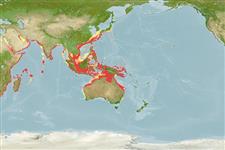ກຸ່ມປາກະດູກອ່ອນ (ເຊັ່ນ: ປາສະຫລາມ, ປາຜາໄລ) (sharks and rays) >
Carcharhiniformes (Ground sharks) >
Hemigaleidae (Weasel sharks)
Etymology: Hemipristis: hemi-, from hemisys (Gr.), half; pristis, from pristes (Gr.), sawyer (but here meaning saw), allusion not explained, possibly referring to how marginal serrations of teeth of H. serra (type species, a fossil) do not extend over the entire length of each tooth. (See ETYFish); elongata: Latin for prolonged, referring to its long and slim body. (See ETYFish).
More on author: Klunzinger.
Environment: milieu / climate zone / depth range / distribution range
ນິເວດວິທະຍາ
ສັດທະເລ ອາໄສຢູ່ໃກ້ໜ້າດິນໃຕ້ພື້ນທ້ອງນ້ຳ; ລະດັບຄວາມເລິກ 1 - 130 m (Ref. 6871). Tropical; 41°N - 34°S, 12°E - 156°E (Ref. 6871)
Indo-West Pacific: Red Sea and southeast Africa, including Persian Gulf (Ref. 68964) to Philippines, north to China, south to Australia.
Length at first maturity / ຂະໜາດ / ນ້ຳໜັກ / Age
Maturity: Lm ?, range 120 - ? cm
Max length : 240 cm TL ຕົວຜູ້/ບໍ່ມີເພດ; (Ref. 5578); common length : 200 cm TL ຕົວຜູ້/ບໍ່ມີເພດ; (Ref. 13567)
ຄີ (ໜາມ)ແຂງຢູ່ຫຼັງປາ (ທັງໝົດ): 0; ຄີຫຼັງຂອງປາ (ຄີອ່ອນ) (ທັງໝົດ): 0; ຄີ(ໜາມ) ແຂງຢູ່ຄີກົ້ນປາ
ກຸ່ມປາກະດູກແຂງ
ຄວາມຖີ່ຂອງກຸ່ມຖ່າຍທອດພັນ
ປາທີ່ມີການເຄື່ອນຍ້າຍຈາກທະເລໄປຫານ້ຳຈືດ ແລະນ້ຳຈືດຫາທະເລ
ປາທີ່ມີການເຄື່ອນຍ້າຍຈາກທະເລແລະໄປໄຂ່ຢູ່ນ້ຳຈືດ
ຄີກົ້ນຂອງປາ
ສັດທີ່ມີກະດູກສັນຫັຼງ
ການຖ່າຍທອດທາງກຳມະພັນຈາກພໍ່ແມ່ຫາລູກ 0; ຄີກົ້ນຂອງປາ: 0. A slender weasel shark with a long, broadly rounded snout, large curved, saw-edged teeth in the upper jaw, and hooked lower teeth protruding from mouth; gill slits long; fins strongly curved (Ref. 5578). Light grey or bronzy with no prominent markings (Ref. 5578).
A coastal species, found inshore and offshore on the continental and insular shelves (Ref. 244). Feeds on sharks, rays and bony fishes (Ref. 244); also cephalopods (Ref. 13567). Viviparous (Ref. 50449). Thought to be potentially dangerous because of its large, fearsome teeth and shallow-water habitat, but has not been recorded in an attack on people (Ref. 244). Caught regularly by inshore gillnet, bottom trawl (occasionally) and longline fisheries (Ref.58048). Regularly taken in artisanal fisheries (Ref. 13567). Utilized fresh for human consumption, liver processed for vitamins, fins used in the oriental shark fin trade, and by-products processed into fishmeal (Ref. 244). Most adults below 200 cm (Ref. 30573).
Viviparous, with 2 to 11 young in a litter (Ref. 6871) after a gestation period of 7-8 months; possibly reproduces in alternate years (Ref.58048). Size at birth about 45-52 cm TL (Ref. 13567, Ref.58048). Distinct pairing with embrace (Ref. 205).
Compagno, L.J.V., 1984. FAO Species Catalogue. Vol. 4. Sharks of the world. An annotated and illustrated catalogue of shark species known to date. Part 2 - Carcharhiniformes. FAO Fish. Synop. 125(4/2):251-655. Rome: FAO. (Ref. 244)
IUCN Red List Status (Ref. 130435)
Threat to humans
Traumatogenic (Ref. 5213)
Human uses
ການປະມົງ: ເປັນສີນຄ້າ
ຂໍ້ມູນຕື່ມອີກ
ເອກະສານອ້າງອີງການລ້ຽງສັດນ້ຳຂໍ້ມູນການລ້ຽງສັດນ້ຳສາຍພັນກຳມະພັນElectrophoresesການຖ່າຍທອດທາງກຳມະພັນຈາກພໍ່ແມ່ຫາລູກພະຍາດການປຸງແຕ່ງNutrientsMass conversion
ຜູ້ຮ່ວມມືຮູບStamps, Coins Misc.ສຽງຫອຍມີພິດຊະນິດນຶ່ງທີ່ອາໄສໃນທະເລຄວາມໄວປະເພດການລອຍເນື້ອທີ່ເຫືອກOtolithsສະໝອງວິໄສທັດ
ເຄື່ອງມື
Special reports
Download XML
ແຫຼ່ງອີນເຕີເນັດ
Estimates based on models
Preferred temperature (Ref.
123201): 23.8 - 29, mean 27.9 °C (based on 2110 cells).
Phylogenetic diversity index (Ref.
82804): PD
50 = 1.0039 [Uniqueness, from 0.5 = low to 2.0 = high].
Bayesian length-weight: a=0.00363 (0.00147 - 0.00899), b=3.07 (2.86 - 3.28), in cm total length, based on LWR estimates for this (Sub)family-body shape (Ref.
93245).
ຊັ້ນເຂດຮ້ອນ (Ref.
69278): 4.3 ±0.3 se; based on diet studies.
ຄວາມຢືດຢຸ່ນ (Ref.
120179): ຕຳ່ຫຼາຍ, ປະຊາກອນຕຳ່ສຸດທີ່ໃຊ້ເວລາສອງເທົ່າຫຼາຍກວ່າ 14 ປີ (Fec=2).
Fishing Vulnerability (Ref.
59153): Very high vulnerability (90 of 100).
Nutrients (Ref.
124155): Calcium = 19.4 [3.2, 106.9] mg/100g; Iron = 0.636 [0.166, 1.913] mg/100g; Protein = 19.3 [17.2, 21.4] %; Omega3 = 0.101 [0.042, 0.245] g/100g; Selenium = 64.4 [18.5, 200.7] μg/100g; VitaminA = 13.4 [4.4, 42.6] μg/100g; Zinc = 0.614 [0.292, 1.120] mg/100g (wet weight);
